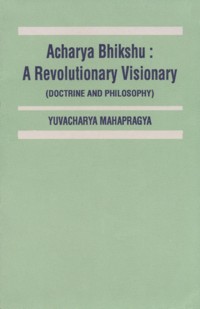One of the aspects of truth is existence. Every substance exists in its own form. Existence is truth because existence does not come to an end. It belongs to all ages - present, past and future. The other aspect of truth is practical knowledge, that is to say, to know a substance as it is, to understand its reality. The first is objective truth. The second is subjective truth. Every philosopher has tried to reach out to truth.
Acharya Bhikshu was a bright star in the.firmament of philosophy. He was not a student of philosophy. He was a seer and therefore philosophy blossomed through his thinking and speech. He expounded both language and metaphysics in depth. Language philosophy claims priority over metaphysics in importance. Even science recognises that determination of language should precede any exposition. Does our language represent what we want to say? In this connection Jain philosophers proposed the philosophy of the use of language.
Acharya Umaswati writes: The range of a substance is determined by निक्षेप (elimination).[24] According to Jinbhadragani, a person who does not interpret meaning through निक्षेप (elimination), नय (standpoint) and प्रमाण (verification), the three procedures recommended by the philosophy of the use of language, will find illogical substances logical and vice versa.[25] Acharya Bhikshu used the निक्षेप procedure and propounded a theory. He made an insightful contribution in explicating nonviolence (अहिंसा) compassion (दया) and charity (दान). The agams mention these concepts and so do the commentators who came after Mahavir. But hardly has any acharya given as learned an interpretation of these concepts based on Agams as Acharya Bhikshu.
The principles and philosophy of Terapanth are not at variance with Jain philosophy. The biggest evidence that Acharya Bhikshu had in his support was the agam - Jinwani. On the basis of the agam he gave a theoretical explanation of nonviolence and compassion. On account of his natural inborn talent, he suggested such new elements as are not found even in ancient canonical literature.
Nonviolence is a negative term. It has two aspects: absolute and relative. Asutra about absolute nonviolence occurs in a verse by Acharya Haribhadra. According to the nonconventional standpoint (निश्चय नय) the soul itself is nonviolence or violence. One who is spiritually aware (अप्रमत) is nonviolent, while one who is spiritually unaware (प्रमत) is violent.[26]
An untinted soul devoid of the passions of attachment and hatred is nonviolence. This is the positive form of nonviolence. The other aspect of nonviolence is found in the Acharanga Sutra: (सव्व पाणा न हन्तव्वा) That is the negative form of nonviolence. Mahatma Gandhi writes: For the continuance of human life killing of some life is inevitable. Which is why the highest religion has been defined by a negative term -nonviolence. This word is trapped in the chain of killing. In other words, violence is in a natural sense unavoidable for keeping alive. Therefore a devotee of nonviolence always prays that he be released from the bondage of this body.[27]
In the manusmriti the metaphor of slaughter-house has been used for the means to satisfy the needs of daily life and five yagyas have been prescribed for its purification.
T.L. Vaswani has also posited these two aspects of nonviolence. Treat all beings as you treat yourself and do not harm anyone." In these words is inherent the two-meaning principle of nonviolence - positive and negative. In the former the focus is only unity: See yourself in all others. The negative meaning lies in: Do not harm anyone. Seeing oneself in all others amounts to refraining from harming others. This sense of non-hurting others originates from the vision of the one in many.[28]
अत्थम् जो न समिक्खई, निक्खेव नयप्पमाणओ विहिणा I
तस्सा जुतं जुतं जुतं जुतंमजुते व पडीहाई II
आया चेव अहिंसा, आया हिंसति निच्छओ एस I
जो होई अप्पभन्तो अहिंसओ, हिंसओ इअरो II
 Yuvacharya Mahaprajna
Yuvacharya Mahaprajna
